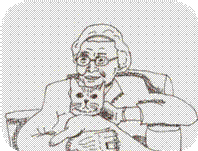More than 70 percent of adult Americans do not have any form of an estate plan legally filed, according to Good Morning America financial contributor, Mellody Hobson. Yet, the process of setting up an estate plan is actually less complicated than one may think. Seniors come from a generation where it was inappropriate to discuss money and death, and therefore, many adult children may find that their parents do not have the appropriate paperwork in place to manage their estates. Or, the senior may not have formal paperwork because they feel that they will just hand down their belongings to their children so there is no need for it.
What happens to an estate without an estate plan
Without an estate plan, decisions about an individual’s property, medical, and final arrangements will be made without input from the individual. Attending doctors or the hospital will make medical decisions, family members will decide on burial arrangements, and state law will dictate the distribution of assets. These considerations alone may be enough to convince a senior that now is the time to formally organize their wishes for the treatment of their medical care and property.
Becoming proactive toward estate planning
Getting started may feel overwhelming, but keeping it simple and enlisting professionals can help streamline the process and bring peace of mind for the whole family. The conversation about estate planning can be a tough one to start with a loved one, but one that is well worth it in the end because of the time and money it will save the estate and the family members who must sort out the details. Caring.com suggests these initial considerations for anyone who is looking at his or her estate:
- What are my assets and what is their approximate value?
- Which people or organizations do I want to have these assets, and do I wish to give them up during my lifetime or after my death?
- Who should manage these assets during my lifetime if I become unable to do so or after my death if management is needed?
- Who should make decisions about my medical care and finances if I cannot make them?
- After I die, do I want my remains to be donated, cremated, scattered, or buried?
These questions all guide an individual to begin to set up an estate plan. Estate planning is a process where an individual indicates in writing how his or her money and other property should be managed while he or she is alive and after death, and what should happen in the event that an individual becomes mentally incapable of making financial or health-related decisions.
The basic documents that experts recommend that an individual have in an estate plan are a will or a living trust, a durable power of attorney for finances and health care, and advanced medical directives. Depending on the complexity of the estate, other documents may be necessary. Ask professionals, such as an estate attorney, an elder law attorney, a financial planner, and a physician, for guidance with these documents if you are not sure.
A will and a living trust
A will is the most basic estate planning tool and may be all the planning that someone needs. It is a document that names one or more people to manage a person’s estate and declares specific transfer of property. It could be made public and go through probate. A living trust is a more common estate planning document these days. It allows people to control their own assets during their lifetimes and then change ownership of the property in the trust to a named trustee at the time of death. The property is not processed through probate or made public.
Family Education cites three basic reasons why people write wills or create trusts. They want to:
- Pass their assets on to their family members rather than let the government take over their assets.
- Keep peace in the family by identifying who gets what.
- Plan ahead for the costs of incapacity, including the care of their spouse.
Each state has laws regarding setting up wills and living trusts. MetLife has a booklet that helps guide people in creating a will. Download a copy of MetLife’s free booklet on “Estate Planning: understanding distribution of assets and estate taxes.”
- Starting a conversation with a parent:
- “You have saved wisely over the years and have many beautiful possessions. I really want to carry out your wishes for the future of all that you have accomplished, but I need to better understand them. Do you want to pass down property to the family? Do you want to be able to draw down money from your assets to help care for you and Mom?”
- Acknowledge that you fully understand that this is their money. Emphasize that advanced planning on their part means that they can keep control over what happens to the possessions they have spent a lifetime collecting. Your goal is to help them keep control – not relinquish it to the government or strangers in a courtroom.
- Stay focused on your parents’ concerns. This is about them, not your needs and wants. They may be worried that they will outlive their resources or that the kids will fight over the estate. They may be struggling with finding a fair way of dividing up what they’ll leave behind without causing problems between family members. Listen to what they are really concerned about and help them find resolution.
- If you feel they’re uncomfortable talking with you, ask them to see a financial planner who is an objective third party.
Opening up the conversation with parents about a will or a living trust can be difficult. Express appreciation for the lifetime of saving they have accomplished, and try these approaches: (sources: Family Education, MetLife):
Power of attorney for finances
With power of attorney document, an individual names a trusted person to handle their financial matters if they become unable to handle them on their own. In the event that this document is not on file when a person becomes mentally incompetent, a judge will then appoint someone to manage the finances for them, even if the person appointed is unfamiliar with the individual or their money matters.
If your parent wants to appoint you as their power of attorney, they should inform you of their decision and share with you their financial situation and specific wishes.
- Starting a conversation with a parent:
Protecting assets is the main focus here. Given the gravity of the topic – money – emotions can run high. Encourage your parent that it is in his or her best interest to appoint a person whose actions have shown that he or she can be trusted to manage your parent’s finances should something happen. This is an opportunity to assure that the money your parent has spent a lifetime accruing is in the best possible hands.
Advance medical care directives and power of attorney for health care
These documents are crucial when the individual is no longer capable of making decisions about life-prolonging treatments and medical care in a hospital, whether because of a lengthy illness or a sudden unexpected accident.
Advance medical directives specify your treatment wishes, such as a “do not resuscitate order”, tests, surgery, medication, and organ donation. This document clearly indicates which course of action the doctor, hospital and your appointed power of attorney for health care should take with regards to your health if you are unable to communicate that yourself.
The power of attorney for health care, or health care proxy, is someone that is named by the individual who is trusted by the individual to carry out the advance medical directives and to make medical related decisions that would align with the individual’s wishes should the advance medical directives not specifically cover that issue.
The person who is appointed as the power of attorney for health care should be very familiar with the wishes, any religious and cultural beliefs of the individual that could affect health care decisions. It is best to talk at length about all aspects of a potential medical crisis and the types of decisions that the individual would favor.
- Starting a conversation with a parent:
Health care and medical conversations of this type are never easy because they focus on the realities of end-of-life. Assure your parent that you want them to be as comfortable as possible in the event of an illness or accident and that you have their best interest at heart. Communicate your willingness to abide by their wishes in the event that you are all faced with this situation.
General rules of thumb apply as an adult child approaches estate planning conversations with parents. Always include as many of your siblings or other appropriate family members as you can, so no one feels like they are being left out of the process. The family may appoint one person to discuss all these estate planning documents with the parents or decide that working as a group would be best.
Keep the discussion focused on how to protect the assets the parents have worked so hard to acquire and how to protect their wishes when their health and comfort is at risk. Ultimately, the goal of estate planning is to allow the individual to feel like they have more control over their assets and their health/medical planning than they did before the creation of documents. Legally that is true, so the approach taken with the senior parents should reflect just that. Once the documents are drawn up, they need to be reviewed and revisited periodically or when there has been a life-altering event, such as a death or divorce.
Make your parents and their goals and wishes the primary focus of every discussion and the estate planning will move forward and provide peace of mind for the whole family.
![]() Visit the CSA blog: www.csa.us/blog
Visit the CSA blog: www.csa.us/blog
![]() Follow SCSA on Twitter: www.twitter.com/SocietyCSA
Follow SCSA on Twitter: www.twitter.com/SocietyCSA
![]() Visit SCSA on LinkedIn:www.linkedin.com/in/jessicamcramer
Visit SCSA on LinkedIn:www.linkedin.com/in/jessicamcramer


